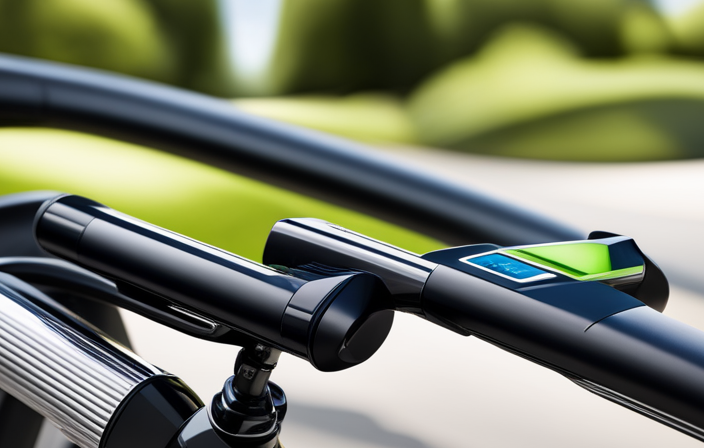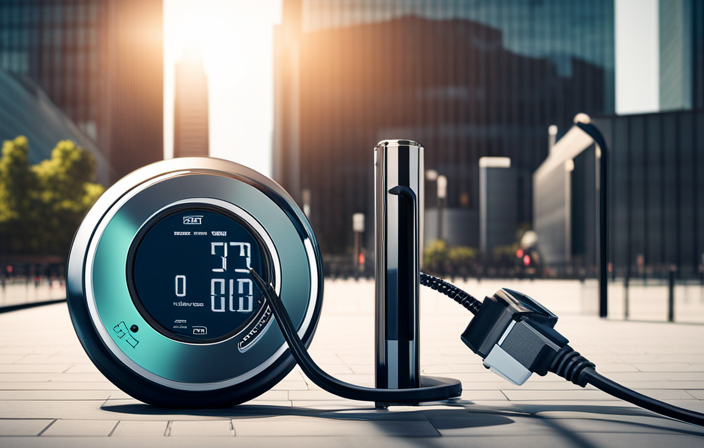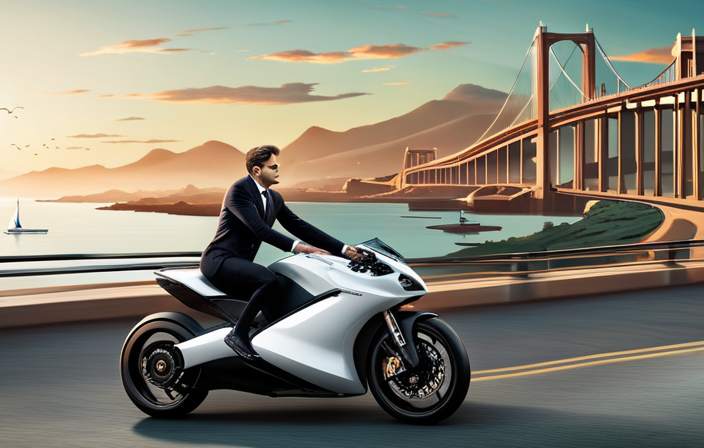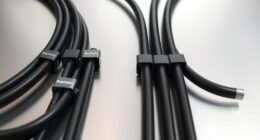I’ve got some exciting news for all you electric bike enthusiasts out there! If you’ve ever wished you could charge your devices on the go while riding your electric bike, then this article is for you.
Today, I’m going to show you exactly how to add a USB port to your electric bike battery. With just a few simple steps, you’ll be able to power up your phone, GPS, or any other USB-powered device right from your bike.
So, let’s get started and turn your electric bike into a charging station on wheels!
Key Takeaways
- Conveniently charge devices on the go
- Tap into the bike’s battery power
- Stay connected without draining phone battery
- Eliminate the need for external power sources
Assess Your Electric Bike Battery
First, you’ll want to assess your electric bike battery to determine if it’s compatible for adding a USB port. Evaluating battery capacity is crucial in this process. Check the voltage and capacity of your battery to ensure it can handle the additional load of a USB port.
It’s important to note that adding a USB port may slightly reduce the battery’s overall capacity. However, there are ways to mitigate this impact and extend battery life. You can consider using a power management system or a voltage regulator to optimize power usage and prevent excessive drain.
Once you have evaluated your battery and ensured its compatibility, you can proceed to choose the right USB port for your electric bike.
Choose the Right USB Port
To ensure you select the correct USB port, consider the charging requirements of your devices and the power output of the available options. Choosing a compatible USB port is crucial to avoid common mistakes when adding it to your electric bike battery.
Here are some key points to keep in mind:
-
Check the voltage requirement of your devices: Different USB ports have different voltage outputs. Make sure the USB port you choose matches the voltage required by your devices.
-
Determine the power output of the USB port: USB ports have varying power outputs, typically measured in amps. Ensure that the USB port can provide enough power to charge your devices efficiently.
-
Consider the number of USB ports needed: Depending on your requirements, you may need a single USB port or multiple ports. Choose a USB port that meets your charging needs.
-
Check the compatibility with your electric bike battery: Ensure that the USB port is compatible with the electrical system of your electric bike battery.
By considering these factors, you can select the right USB port that meets your charging requirements and avoids any potential compatibility issues.
Now, let’s move on to the next section and gather the necessary tools and materials.
Gather the Necessary Tools and Materials
Now, you’ll want to make sure you have all the tools and materials necessary for this step. Exploring alternative power sources and troubleshooting common USB port issues require a specific set of equipment. Here’s what you’ll need:
- USB port module: This is the main component that will allow you to connect your devices to the electric bike battery.
- Wire stripper: To remove the insulation from the wires and make clean connections.
- Soldering iron: Essential for soldering the wires to the USB port module.
- Heat shrink tubing: Used to insulate and protect the soldered connections.
- Electrical tape: Provides extra insulation and protection against moisture.
- Wire connectors: These will help you make secure and reliable connections.
With these tools and materials in hand, you’ll be ready to move on to the next step of locating a suitable mounting location for your USB port, ensuring easy access and convenience while riding your electric bike.
Locate a Suitable Mounting Location
Once you have gathered all the necessary tools and materials, it’s time to find a suitable mounting location for your USB port on your electric bike. This step is crucial as it determines the accessibility and functionality of your USB port.
Here are three key considerations for finding the best mounting location:
-
Accessibility: Choose a location that is easily reachable while riding your electric bike. Consider areas such as the handlebar or the top tube for convenient access.
-
Protection: Ensure that the mounting location provides adequate protection for your USB port against water, dust, and other elements. Look for options that come with waterproof or weather-resistant features.
-
Power Output: Determine the power output required for your USB port based on the devices you plan to charge. Different brands offer varying power outputs, so select one that suits your needs.
With a suitable mounting location in mind, you can now proceed to prepare the electric bike battery for installation, ensuring a seamless integration of the USB port into your electric bike setup.
Prepare the Electric Bike Battery for Installation
Before proceeding with the installation of the electric bike battery, it’s crucial to disconnect the battery from any power source. This can be done by locating the main power switch or disconnecting the battery terminals.
Ensuring safety precautions, such as wearing protective gloves and eyewear, is essential to avoid any potential accidents or injuries during the disconnection process.
Disconnecting the Battery
To disconnect the battery, you’ll need to locate the power switch and turn it off. This step is crucial to ensure your safety and avoid any potential risks during the process. Once you have found the power switch, simply flip it to the off position. This will effectively disconnect the battery from the electrical system of your electric bike. To help you visualize this, here is a table showcasing the different mounting options for the power switch:
| Mounting Option | Description |
|---|---|
| Handlebar Mount | The power switch is mounted on the handlebar for easy access and visibility. |
| Frame Mount | The power switch is mounted directly on the bike frame for a sleek and integrated look. |
| Seatpost Mount | The power switch is mounted on the seatpost, providing a convenient location for easy operation. |
With the battery safely disconnected, we can now move on to ensuring safety precautions in the next section.
Ensuring Safety Precautions
Now that the battery has been safely disconnected, it is crucial to discuss the importance of proper grounding for the USB port installation on an electric bike.
Proper grounding ensures the safe flow of electrical current and prevents the risk of electrical shock or damage to the bike’s electrical system. When installing the USB port, it is essential to follow the manufacturer’s instructions carefully, ensuring that the grounding wire is securely connected to a suitable grounding point on the bike’s frame.
Failure to establish proper grounding may result in electrical malfunctions or even pose a safety hazard.
Additionally, it is important to consider the potential risks of using a USB port while riding an electric bike. These risks include distractions, reduced focus on the road, and potential damage to connected devices due to vibrations or impacts.
With safety precautions in mind, let’s now transition into the subsequent section on how to install the USB port.
Install the USB Port
First, grab your soldering iron and carefully attach the positive and negative wires of the USB port to the corresponding terminals on the electric bike battery. This step is crucial for installing additional features and reaping the benefits of having a USB port on an electric bike.
By adding a USB port, you can conveniently charge your devices while on the go, whether it’s your smartphone, GPS, or even a portable speaker. The USB port allows you to tap into the battery power of your electric bike, eliminating the need for external power sources. This means you can stay connected and powered up during your rides without worrying about draining your phone’s battery.
Now that the USB port is securely attached to the battery, let’s move on to connecting it to the electric bike’s system.
Connect the USB Port to the Electric Bike Battery
After securely attaching the USB port to the battery, the next step is to connect it to the electric bike’s system. This step is crucial as it allows the USB port to access the bike’s power source and provide charging options for various devices.
To ensure a successful connection, follow these precise steps:
- Locate the power output connector on the electric bike’s system.
- Insert the corresponding end of the USB port cable into the power output connector.
- Secure the connection by firmly pushing the cable into the connector until it clicks into place.
By connecting the USB port to the electric bike’s system, you can harness its power output to charge your devices on the go.
Now that the USB port is properly connected, it’s time to test its functionality and charging capabilities.
Test the USB Port
To ensure everything is working properly, you should try plugging in a device to test the functionality of the USB port. This is an essential step in the testing process to troubleshoot common issues.
Start by connecting the USB cable from your device to the USB port on the electric bike battery. Make sure the connection is secure. Once connected, power on the device and check if it is recognized by the bike’s system. If the device is not recognized, there may be a problem with the USB port or the wiring. In this case, you may need to double-check the connections and ensure that the wiring is properly installed.
If the device is recognized, try transferring some data or charging the device to further test the USB port’s functionality. This will help you determine if the USB port is working as intended.
Now that we have tested the USB port, we can move on to reassembling the electric bike battery and completing the installation process.
Reassemble the Electric Bike Battery
Now that you have tested the USB port, it’s time to put the electric bike battery back together.
Reassembling the battery requires careful attention to detail and following specific techniques. Start by aligning the battery casing and ensuring that all the internal components are properly placed. Secure the casing using the screws or fasteners provided.
Double-check all connections to make sure they are snug and secure. Troubleshooting common issues during reassembly includes checking for any loose wires or connectors and ensuring that the battery terminals are clean and free from corrosion.
Once you have completed the reassembly process, you can now enjoy your newly equipped electric bike, ready to power your adventures with the added convenience of a USB port.
Enjoy Your Newly Equipped Electric Bike
When it comes to charging devices on the go, having a reliable power source is crucial.
In this discussion, I will explore the various possibilities for charging your devices while riding your electric bike.
From installing a USB port to utilizing solar panels, I will provide detailed insights into how you can ensure a constant and convenient power supply for all your devices during your electric bike adventures.
Charging Devices On the Go
You can easily charge your devices while riding with a USB port added to your electric bike battery. This feature adds a whole new level of portability and convenience to your electric bike experience.
With the USB port, you can charge your smartphone, GPS device, or any other USB-powered device directly from your bike’s battery. No more worrying about running out of battery on your devices while exploring new trails or navigating through unfamiliar areas.
Simply plug in your device to the USB port, and let your bike’s battery do the rest. This innovative addition opens up a world of possibilities for your electric bike, allowing you to stay connected and explore new areas without any worries.
Exploring New Possibilities for Your Electric Bike
With this innovative feature, my electric bike opens up a whole new world of possibilities for exploration. One of the key benefits is the ability to charge my devices on the go.
Adding a USB port to my electric bike battery allows me to conveniently charge my phone, GPS device, or any other USB-powered device while I’m riding. This means I can stay connected and navigate without worrying about running out of battery.
Additionally, having a USB port on my electric bike gives me more flexibility when it comes to charging options. I can charge my devices directly from the bike’s battery, eliminating the need for extra power banks or adapters. This not only saves space but also ensures that I always have a reliable power source wherever I go.
Overall, the addition of a USB port to my electric bike battery greatly enhances my riding experience and expands the possibilities for exploration.
Frequently Asked Questions
Can I add a USB port to any electric bike battery?
Yes, you can add a USB port to most electric bike batteries. This allows you to conveniently charge your devices while riding. The benefits of a USB port include easy access to power for charging phones, GPS devices, and other USB-compatible devices.
How much does it typically cost to add a USB port to an electric bike battery?
The cost range for adding a USB port to an electric bike battery can vary depending on factors like battery type and installation complexity. It typically ranges from $50 to $100, and the installation process involves connecting the port to the battery’s power circuit.
Will adding a USB port to my electric bike battery void its warranty?
Adding a USB port to an electric bike battery may void its warranty. DIY modifications can pose potential risks, such as damaging the battery or causing electrical issues. Alternatives include using portable power banks or purchasing bikes with built-in USB ports.
Is it possible to charge my electric bike’s battery through the USB port?
Yes, it is possible to charge an electric bike’s battery through a USB port. However, it is important to note that USB ports have limitations in terms of power output and may not provide sufficient charging capacity for the battery.
Can I use the USB port on my electric bike battery to power other devices while riding?
Yes, the USB port on my electric bike battery can be used to power other devices while riding. However, it is important to consider the charging options and safety considerations to ensure proper functionality and avoid any potential hazards.
Conclusion
In conclusion, adding a USB port to your electric bike battery is a simple and worthwhile upgrade. By following the steps outlined in this article, you can easily connect a USB port to your battery and enjoy the convenience of charging your devices while on the go.
While some may argue that this modification is unnecessary, it is important to consider the practicality and versatility it offers. With a USB port, you can stay connected and powered up wherever your electric bike takes you.
So why not take advantage of this easy upgrade and enhance your electric biking experience.









